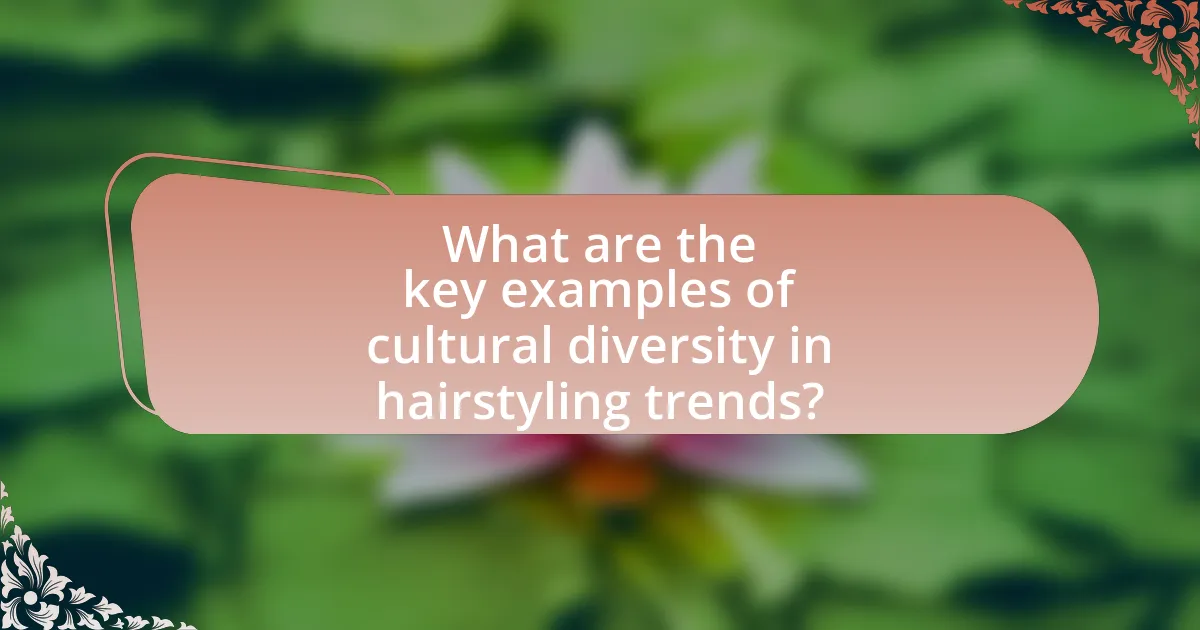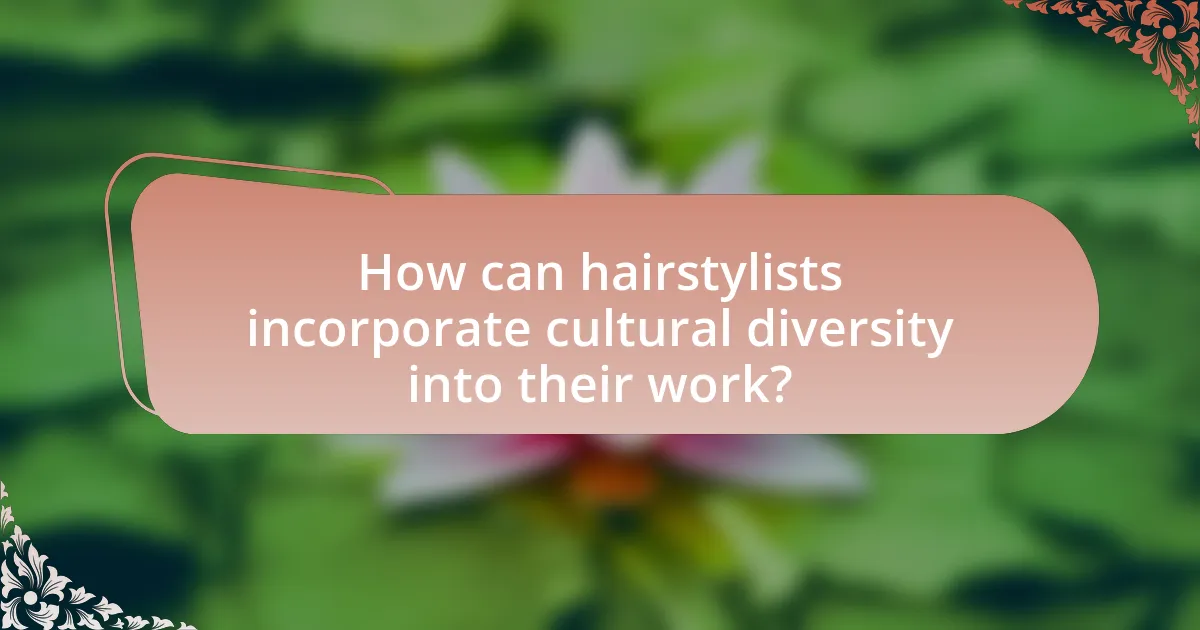The article examines the significant influence of cultural diversity on hairstyling trends, highlighting how various cultural backgrounds introduce a range of styles, techniques, and aesthetics. It discusses the impact of cultural factors, historical events, and social norms on hairstyling preferences, emphasizing the importance of understanding cultural diversity for hairstylists. Key examples of traditional hairstyles from different cultures are provided, along with insights into how modern interpretations emerge and the role of celebrities and social media in promoting diverse hairstyles. The article also addresses the challenges hairstylists face in embracing cultural diversity and offers practical tips for celebrating inclusivity in their work.

What is the Influence of Cultural Diversity on Hairstyling Trends?
Cultural diversity significantly influences hairstyling trends by introducing a variety of styles, techniques, and aesthetics from different cultures. For instance, the popularity of braids and natural hairstyles in Western fashion has been largely inspired by African and Afro-Caribbean cultures, reflecting a growing appreciation for ethnic diversity. Additionally, the incorporation of traditional hairstyles, such as Indian mehndi or Japanese geisha styles, into mainstream fashion showcases how cultural elements can reshape contemporary hairstyling. This blending of cultural influences not only diversifies the hairstyling landscape but also promotes inclusivity and representation within the beauty industry.
How does cultural diversity shape hairstyling preferences?
Cultural diversity significantly shapes hairstyling preferences by influencing styles, techniques, and the significance of hair in various communities. Different cultures have unique traditions and values associated with hair, such as the importance of hair texture, length, and styling methods that reflect identity and heritage. For instance, African cultures often celebrate natural hair textures through styles like braids and afros, which serve as expressions of cultural pride and resistance against Eurocentric beauty standards. In contrast, Asian cultures may emphasize sleek, straight hair, often associated with beauty and professionalism. Studies, such as those published in the Journal of Cultural Studies, highlight how these cultural norms dictate not only personal choices but also trends in the hairstyling industry, leading to a rich tapestry of styles that reflect the diverse backgrounds of individuals.
What cultural factors contribute to diverse hairstyling trends?
Cultural factors such as ethnicity, historical context, and social norms significantly contribute to diverse hairstyling trends. Ethnic backgrounds influence hair texture and traditional styles, with specific communities often embracing unique hairstyles that reflect their heritage, such as braids in African cultures or intricate updos in Asian cultures. Historical context plays a role as well; for instance, the 1960s civil rights movement popularized afros as a symbol of pride among African Americans. Social norms, including fashion trends and celebrity influence, further shape hairstyling preferences, as seen in the adoption of styles popularized by public figures across various cultures. These elements collectively create a rich tapestry of hairstyling diversity, reflecting the values and identities of different cultural groups.
How do historical events influence current hairstyling trends?
Historical events significantly shape current hairstyling trends by reflecting cultural shifts, societal norms, and technological advancements. For instance, the 1960s counterculture movement popularized long hair for men and women as a symbol of rebellion against traditional values, influencing modern styles that embrace individuality and self-expression. Additionally, the introduction of the Afro hairstyle during the Civil Rights Movement represented pride in African heritage, leading to a resurgence of natural textures in contemporary fashion. These examples illustrate how historical contexts inform and inspire current hairstyling choices, demonstrating the ongoing dialogue between past and present cultural identities.
Why is understanding cultural diversity important in hairstyling?
Understanding cultural diversity is important in hairstyling because it enables stylists to cater to a wide range of hair types, textures, and styling preferences that are influenced by cultural backgrounds. Different cultures have unique hair care practices and styles, which can significantly impact client satisfaction and loyalty. For instance, African American hair often requires specific techniques and products that differ from those used for straight or wavy hair types common in Caucasian or Asian communities. By recognizing and respecting these differences, hairstylists can provide personalized services that meet the diverse needs of their clientele, ultimately enhancing their professional reputation and business success.
What impact does cultural awareness have on hairstyling professionals?
Cultural awareness significantly enhances hairstyling professionals’ ability to cater to diverse clientele effectively. By understanding various cultural norms, preferences, and hair types, hairstylists can provide tailored services that meet the specific needs of clients from different backgrounds. For instance, knowledge of Afro-textured hair care techniques allows stylists to offer appropriate services to clients with African heritage, which is crucial given that 70% of African American women report using hair care products specifically designed for their hair type. This cultural competence not only improves client satisfaction but also fosters a more inclusive salon environment, ultimately leading to increased customer loyalty and business growth.
How can cultural diversity enhance creativity in hairstyling?
Cultural diversity enhances creativity in hairstyling by introducing a wide array of techniques, styles, and inspirations from various traditions and backgrounds. This variety allows hairstylists to blend different cultural elements, resulting in innovative and unique hairstyles that reflect a fusion of influences. For instance, the incorporation of African braiding techniques, Asian cutting styles, and Western coloring methods can lead to fresh, original looks that appeal to a broader audience. Studies have shown that diverse teams are more creative, as they bring different perspectives and problem-solving approaches, which is particularly relevant in the hairstyling industry where creativity is paramount.

What are the key examples of cultural diversity in hairstyling trends?
Key examples of cultural diversity in hairstyling trends include the use of braids in African cultures, the intricate hairstyles of Indigenous peoples, and the popularity of Asian-inspired haircuts such as the bob and layered styles. Braids, such as cornrows and box braids, have historical significance in African communities, often symbolizing social status and identity. Indigenous hairstyles, often adorned with beads and feathers, reflect cultural heritage and traditions. Asian hairstyles, particularly the bob cut, gained global popularity in the early 20th century, showcasing the influence of Japanese and Chinese aesthetics on Western fashion. These examples illustrate how hairstyling trends are shaped by cultural practices and values, highlighting the rich tapestry of global influences in personal grooming.
How do different cultures express identity through hairstyling?
Different cultures express identity through hairstyling by utilizing specific styles, techniques, and symbolism that reflect their unique traditions and values. For instance, in African cultures, intricate braiding patterns often signify social status, age, or community affiliation, while in Native American cultures, hairstyles can represent tribal identity and personal achievements. Additionally, in Asian cultures, hairstyles like the traditional Japanese geisha’s elaborate updo convey cultural heritage and artistry. Historical practices, such as the use of hair as a form of resistance or empowerment, further illustrate how hairstyling serves as a powerful medium for cultural expression.
What are some traditional hairstyles from various cultures?
Traditional hairstyles from various cultures include the Japanese Geisha’s elaborate updos, the African Fulani braids, the Native American long, flowing hair often adorned with feathers, and the Indian braid adorned with flowers. Each of these hairstyles reflects cultural significance; for instance, Geisha hairstyles symbolize beauty and artistry, while Fulani braids often indicate social status and ethnic identity. Historical records show that these hairstyles have been practiced for centuries, highlighting their deep-rooted cultural importance and the influence of tradition on hairstyling trends.
How do modern interpretations of traditional hairstyles emerge?
Modern interpretations of traditional hairstyles emerge through the blending of cultural influences, contemporary fashion trends, and individual creativity. This process often involves adapting historical styles to fit current aesthetics, utilizing modern techniques and products that enhance the original designs. For example, the resurgence of braids in mainstream fashion reflects a combination of African heritage and modern styling, showcasing how traditional elements can be reimagined for today’s audience. Additionally, social media platforms amplify these interpretations by allowing diverse voices to share and promote their unique takes on traditional hairstyles, further driving innovation and acceptance in hairstyling trends.
What role do celebrities and influencers play in promoting diverse hairstyles?
Celebrities and influencers play a crucial role in promoting diverse hairstyles by showcasing a variety of looks that reflect different cultural backgrounds and hair types. Their visibility on social media platforms and in mainstream media allows them to set trends and normalize diverse hairstyles, making them more accepted and celebrated in society. For instance, when celebrities like Zendaya and Lupita Nyong’o wear natural hairstyles or traditional cultural styles, they not only highlight the beauty of diversity but also inspire their followers to embrace their own unique hair textures and styles. This influence is supported by research indicating that representation in media significantly impacts public perception and acceptance of different cultural expressions, thereby fostering a more inclusive beauty standard.
How do social media platforms impact the visibility of diverse hairstyling trends?
Social media platforms significantly enhance the visibility of diverse hairstyling trends by providing a global stage for users to share and discover various styles. These platforms, such as Instagram and TikTok, utilize algorithms that promote content based on user engagement, allowing unique and culturally diverse hairstyling trends to reach wider audiences rapidly. For instance, a study by the Pew Research Center found that 69% of adults in the U.S. use social media, which facilitates the rapid dissemination of hairstyling ideas across different demographics. This increased exposure not only encourages the adoption of diverse styles but also fosters cultural exchange and appreciation within the beauty community.
What are some notable examples of celebrities embracing cultural hairstyles?
Notable examples of celebrities embracing cultural hairstyles include Zendaya, who has worn traditional African braids, and Rihanna, who has sported various styles inspired by her Barbadian heritage, such as cornrows and Bantu knots. These choices highlight the influence of cultural diversity on hairstyling trends, as both celebrities have used their platforms to celebrate and promote cultural hairstyles, thereby raising awareness and appreciation for their origins.

How can hairstylists incorporate cultural diversity into their work?
Hairstylists can incorporate cultural diversity into their work by actively learning about and embracing various hair types, textures, and styling techniques from different cultures. This approach allows hairstylists to cater to a broader clientele and respect the unique beauty standards and traditions associated with diverse backgrounds. For instance, understanding the specific needs of Afro-textured hair, which requires different care and styling methods compared to straight hair, enables hairstylists to provide tailored services. Additionally, hairstylists can participate in workshops and training focused on multicultural hair care, which enhances their skills and knowledge. This commitment to cultural diversity not only enriches the hairstylist’s repertoire but also fosters an inclusive environment that celebrates individuality and cultural heritage.
What best practices should hairstylists follow when working with diverse clients?
Hairstylists should prioritize cultural competence when working with diverse clients. This involves understanding and respecting the unique hair types, textures, and cultural significance associated with different hairstyles. For instance, stylists should be knowledgeable about the specific needs of textured hair, which often requires different products and techniques compared to straight hair. Research indicates that 70% of Black women prefer to wear their natural hair, highlighting the importance of stylists being skilled in natural hair care and styling methods. Additionally, effective communication is crucial; hairstylists should actively listen to their clients’ preferences and concerns to ensure satisfaction. By implementing these best practices, hairstylists can create an inclusive environment that respects and celebrates diversity in hairstyling.
How can hairstylists educate themselves about different cultural hairstyles?
Hairstylists can educate themselves about different cultural hairstyles through targeted research, workshops, and community engagement. Engaging in cultural studies and attending specialized training sessions can provide insights into the historical significance and techniques of various hairstyles. For instance, organizations like the Professional Beauty Association offer resources and courses that focus on multicultural hair care. Additionally, hairstylists can connect with diverse communities to learn directly from individuals about their hair traditions and practices, enhancing their understanding and skills. This approach not only broadens their expertise but also fosters inclusivity in their services.
What resources are available for hairstylists to learn about cultural diversity?
Hairstylists can access various resources to learn about cultural diversity, including online courses, workshops, and literature focused on multicultural hair care techniques. For instance, platforms like Skillshare and Udemy offer courses specifically addressing diverse hair types and styling methods. Additionally, organizations such as the Professional Beauty Association provide workshops and seminars that emphasize cultural competence in hairstyling. Books like “Hair Story: Untangling the Roots of Black Hair in America” by Ayana D. Byrd and Lori L. Tharps offer historical and cultural insights that are essential for understanding the significance of hair in different cultures. These resources collectively enhance hairstylists’ knowledge and skills in catering to a diverse clientele.
What challenges do hairstylists face when embracing cultural diversity?
Hairstylists face several challenges when embracing cultural diversity, including a lack of knowledge about different hair types and textures, which can lead to unsatisfactory results for clients. Many hairstylists may not have received adequate training in handling diverse hair, resulting in difficulties in providing appropriate services for clients with varying cultural backgrounds. Additionally, there may be communication barriers that arise from cultural differences, making it challenging for hairstylists to understand clients’ specific needs and preferences. Furthermore, the hairstyling industry often lacks representation of diverse cultures, which can limit hairstylists’ exposure to various techniques and styles. These challenges highlight the need for ongoing education and training in cultural competency within the hairstyling profession.
How can hairstylists overcome stereotypes in hairstyling?
Hairstylists can overcome stereotypes in hairstyling by actively promoting inclusivity and showcasing diverse hair types and styles in their work. By embracing a wide range of cultural influences and techniques, hairstylists can challenge narrow definitions of beauty and skill. For instance, hairstylists who specialize in various ethnic hair textures can educate clients and peers about the unique needs and styles associated with those textures, thereby broadening the industry’s understanding of hairstyling. Research indicates that representation in media and advertising significantly impacts societal perceptions; therefore, hairstylists can collaborate with diverse models and influencers to highlight the beauty of all hair types, further dismantling stereotypes.
What are common misconceptions about cultural hairstyles?
Common misconceptions about cultural hairstyles include the belief that they are merely fashion statements rather than expressions of cultural identity and heritage. Many people assume that hairstyles like braids, locs, or traditional head wraps lack significance, overlooking their historical and cultural roots. For instance, African hairstyles often convey social status, age, and community affiliation, while Native American hairstyles can symbolize spiritual beliefs and tribal identity. Additionally, there is a misconception that cultural hairstyles are universally appropriated without consequence, ignoring the cultural significance and potential for disrespect when these styles are worn outside their original context.
What practical tips can hairstylists use to celebrate cultural diversity in hairstyling?
Hairstylists can celebrate cultural diversity in hairstyling by actively incorporating techniques and styles from various cultures into their practice. This can be achieved by researching and learning about traditional hairstyles from different cultures, such as braiding techniques from African heritage or intricate updos from Asian traditions. Additionally, hairstylists should engage with clients to understand their cultural backgrounds and preferences, allowing for personalized services that honor their heritage.
Furthermore, hairstylists can attend workshops and training sessions focused on multicultural hairstyling, which not only enhances their skill set but also promotes inclusivity in their services. By showcasing diverse hairstyles in their portfolios and marketing materials, hairstylists can attract a broader clientele and demonstrate their commitment to celebrating cultural diversity. This approach not only enriches the hairstyling experience but also fosters a more inclusive environment within the beauty industry.


